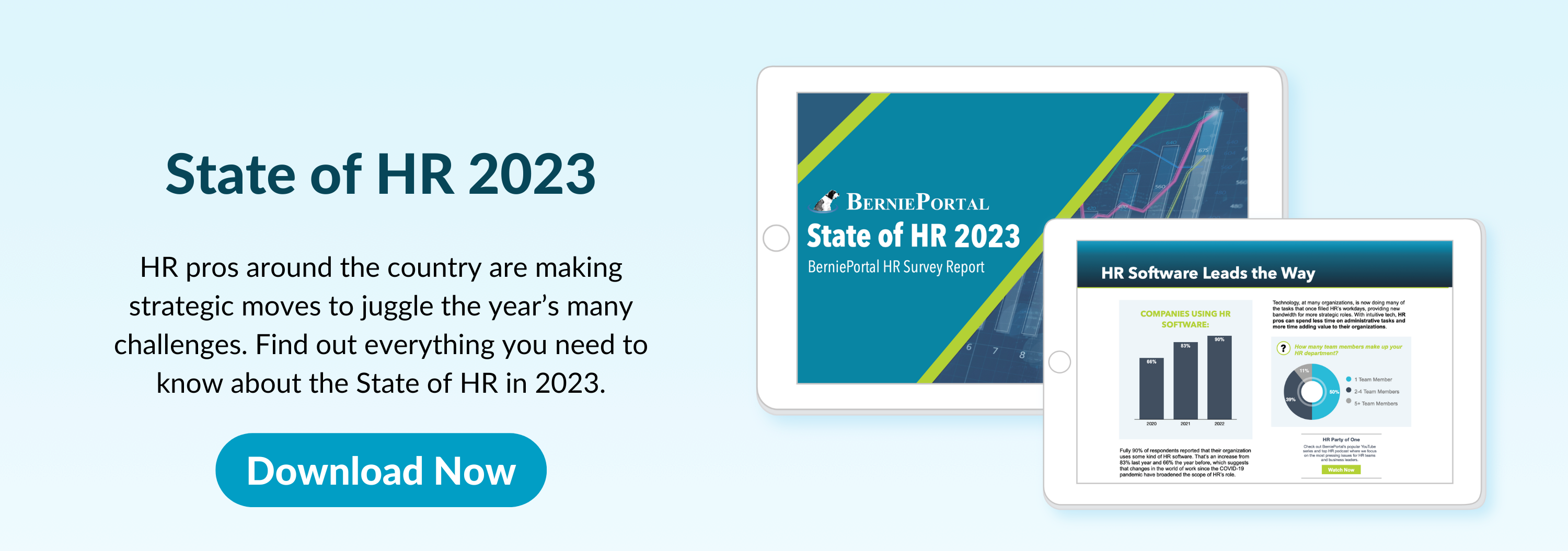Written by
Will Miranne
Will is an aPHR-certified writer on the marketing team at BerniePortal. He writes about healthcare, human resources, and benefits.
HR Guide: Effectively Manage Leaves of Absence

Leaves of absence (LOAs) are an integral part of the responsibilities of HR. Employees are entitled to LOAs regardless of organizational policies when they meet specific criteria. For this reason, HR professionals and managers must remain updated and educated on the laws and requirements governing LOAs.
This guide is here to help you understand LOAs and provide actionable steps toward effectively managing them within your organization.
Know What Constitutes a Leave of Absence
Leaves of absence (LOAs) entitle eligible employees to legal and job-protected time away from work for a specified period. This form of leave differs from traditional paid time off because it is required by federal or state law.
LOAs can be prompted by:
-
Mental health concerns or recovery
-
Chronic or significant health concerns
-
Health emergencies
-
Military leave
-
Childbirth
-
Sick family members
-
Adoption
If an employee is experiencing any eligible circumstances, federal and state laws may qualify them to receive an LOA. Employers should recognize these instances and prepare a plan for employees needing leave.
Some organizations will go one step further by providing additional benefits for leaves. One growing benefit is paid parental leave. While the birth of a child entitles employees to a 12-week leave, some states require employers to pay the employee for the duration of the leave. This applies only to companies that fall under FMLA. Many parental policies will provide employees with partial or fully paid leave for a specific period.
7 Ways for Organizations to Effectively Manage Leaves of Absences
If employers mismanage LOA policies, it could spell legal repercussions for the organization.
To ensure you are managing these policies effectively, focus on these seven steps:
-
Understand all legal obligations and requirements. Educate employees on said requirements.
-
Don’t look for ways around LOAs. Instead, forge a culture that embraces them.
-
Determine LOAs on a case-by-case basis to determine when and how an LOA should end.
-
Document everything. You should keep a record of which employees took an LOA, when they took it, for what purpose, and for how long. HRIS systems, like BerniePortal, can help you to manage this.
-
Continue to save and utilize gathered data so that you can continue to update and improve your LOA policies.
-
Maintain transparency. Let employees know when decisions are made regarding their request for LOA.
-
Include information on LOAs in your Culture Guide. Include proper procedure, examples of LOAs, legal entitlements, and internal policies that go hand in hand with LOAs, such as paid parental leave.
Determine What Is Legally Required for Leaves of Absences
The first priority when managing LOAs is understanding the laws governing them. This means recognizing which laws affect LOAs, how they interact with one another, eligibility requirements, and whether employee benefits offerings from the organization can coincide with said laws.
If you suspect laws may intersect in a specific case, your first step is to dive deeper with that employee. If, for example, an employee has a medical concern, then inquire about the type of health concern and determine whether it falls under Family Medical Leave or Disability Leave. It may even fall under both. Be sure to gather all information to provide accurate leave information and remain fully compliant.
Here are the most important laws and regulations to monitor:
Family Medical Leave Act (FMLA)
FMLA provides eligible employees up to 12 weeks of unpaid, job-protected leave. According to the Department of Labor, employers with at least 50 employees are required by law to provide FMLA leave. This includes schools, public agencies, public organizations, and private organizations.
To be eligible, employees must meet two requirements:
-
They were employed for the previous 12 months
-
They worked a minimum of 1,250 hours in those 12 months
Should they meet eligibility conditions, employees of these covered entities are considered eligible for FMLA under the following conditions:
-
The birth and care of a child
-
Fostering or adopting children
-
Attending to the health needs of an immediate family member
-
Medical leave due to serious health condition
FMLA will also cover certain military-leave policies. This is referred to as “military caregiver leave.” This form of leave was instated following the 9/11 attacks, which prompted the military to bring thousands of individuals in the reserves and national guard into active duty.
Policies covered under FMLA's military caregiver leave include:
-
12 weeks of leave should a family member be called into active duty
-
12 weeks of leave for all “qualifying exigencies” surfacing from a covered employee's spouse, child, or parent having been placed on active duty.
-
26 weeks of paid leave for any family members caring for military veterans injured while on active duty.
The addition of these policies has increased the total number of individuals who may be eligible for FMLA. One important point to note is that employers are required to remain proactive in recognizing FMLA-eligible employees. Employers may believe that if an employee does not seek out FMLA leave, they are not responsible for offering it to the employee. This is false. Employers must notify employees of the legal entitlement to FMLA leave under any circumstances where it would be relevant. One way of accomplishing this is to include these points in your culture guide.
Most employees will take leave all at once, while some may wish to take leave intermittently. Organizations are not, however, required to offer intermittent leave.
Uniformed Services Employment and Reemployment Rights Act (USERRA)
Unlike FMLA leave, USERRA is not limited to organizations of a certain size. USERRA applies to every business and every type of employee. USERRA governs LOAs taken by any member of the uniformed services for training, active duty, fitness requirements, and funeral services. This leave will also apply to reservists, National Disaster Medical System (NDMS) members, and Federal Emergency Management Agency (FEMA) members.
Eligibility requires an employee not to take more than a five-year leave. The benefits offered by USERRA are as follows:
-
Protection from discrimination that occurs due to a person's service in the military
-
Job protection for a time when returning from service
-
Re-employment rights when military service has concluded
-
Specific rights related to pensions and employee benefit plans
USERRA has unique leave policies that differ from FMLA. Understand where these two diverge as you prepare for employee leave.
Workers Compensation Leave
Workers’ compensation occurs when an employee sustains an injury while on the job. The injury and situation surrounding the injury must fall into the parameters of workers’ compensation. Then leave may be required.
The leave applies to every employer regardless of size or scope. That said, small sole proprietors may be eligible to opt out of workers' compensation.
Americans with Disabilities Act ADA
Accommodating Employees’ Disabilities under the Americans with Disabilities Act (ADA) applies to employers with 15 or more employees. Employers need to become familiar with what constitutes a disability.
The ADA requires employers to reach out to employees as soon as they know that a reasonable accommodation may be needed. Some employers may think they are only obligated to reach out to an employee if they inform the employer of a leave request. This is incorrect. All employers must reach out to their employees regardless of whether the employee has requested the leave.
Employers need to understand the requirements set forth by the ADA to understand where the legal requirements overlap with other leave policies. When FMLA leave is exhausted, it can even prompt the need for leave under the ADA.
State Laws
Each state has unique laws and regulations surrounding LOAs, including medical, family, or military reasons. Typically these regulations offer even greater protections for individuals and more generous leave options.
One example is California’s required paid family leave. California is one of 11 states to offer this benefit, and each state's regulations differ slightly. To see how your state's laws interact, use this comparison tool.
Understand Your Policies For LOAs
Every organization should have policies regarding LOAs. Some policies may have very little in addition to what they are legally obligated to offer, while others may offer more comprehensive policies that complement legal obligations. Whatever your policy is, all management and HR staff must be up-to-date and in sync.
In some instances, managers may discuss policy options with employees that do not fully represent the formally established policies. This is often simply a case of management needing to be fully informed. This can especially be true in larger organizations with many executives and managers.
HR must ensure that all management is fully educated on all updates to policies involving LOAs. Be intentional about planning for management training. HR should set aside 3-4 days a year—possibly once per quarter, with some flexibility in your busiest season—and dedicate the entire day to coaching and training your managers. It is the organization's responsibility to ensure information is accurate and made clear to all employees.
Manager manuals should be made available to ensure that all upper-level staff knows what is acceptable and what can be grounds for fraud, non-compliance, and negligence.
How to Effectively Communicate Approvals & Disapprovals
Once a reason for leave has been determined and corresponding laws have been identified, organizations must communicate a final decision to employees. This is a critical step in managing LOAs and MUST BE DONE CORRECTLY.
Failure to correctly determine employee eligibility for a given LOA can result in a damaged reputation, disciplinary action within the organization, and legal action. There have been lawsuits against HR professionals and organizations for standing in the way of an employee's legal rights to LOAs. A recent case involved a correctional officer at Cook County Sheriff’s office who deals with PTSD. He was told he should not take any further FMLA leave due to the amount of time he had missed, even though he still had several weeks remaining on his allotted leave.
Be sure you do not put yourself and your organization in a situation where legal action could be prompted.
Document everything and maintain transparency throughout the process. All documentation should be in writing and made available to the employee. By regularly communicating with employees, you can severely limit the chances of mistakes along the way and ensure you maintain compliance.
Once HR professionals decide whether the LOA will be granted or denied, they must continue to monitor the leave. This includes regularly reaching out to employees on how their leave is going, if anything has changed and when they will be expected to return. Communication is perhaps the most important step in managing LOAs effectively and should never be taken lightly.
Additional Resources
You can also stay informed, educated, and up-to-date with LOAs and other important topics by using BerniePortal’s comprehensive resources:
-
BernieU—free online HR courses, approved for SHRM and HRCI recertification credit
-
BerniePortal Blog—a one-stop-shop for HR industry news
-
HR Glossary—featuring the most common HR terms, acronyms, and compliance
-
HR Guides—essential pillars covering an extensive list of comprehensive HR topics
-
HR Party of One—our popular YouTube series and podcast, covering emerging HR trends and enduring HR topics
Written by
Will Miranne
Will is an aPHR-certified writer on the marketing team at BerniePortal. He writes about healthcare, human resources, and benefits.
Related Posts
FMLA, or the Family and Medical Leave Act, is a federal law that allows qualified...
Selecting the right pay period is vital for optimizing payroll management and aligning...
Recent news has shown business leaders, and particularly human resources professionals,...
The impact of AI in the workplace largely depends on who oversees its use, if anyone....








Submit a Comment